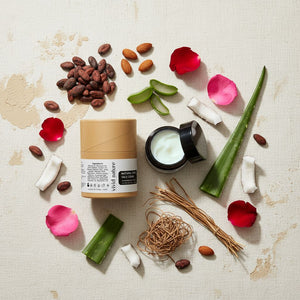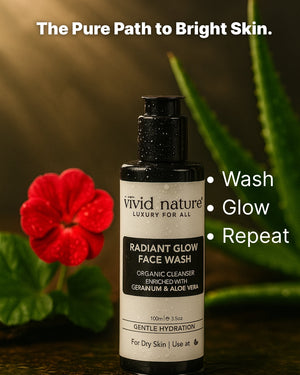Embrace Sharad Ritu with Ayurvedic Skincare Rituals

In the ancient science of Ayurveda, each season of the year is seen as an opportunity to harmonize our inner and outer environments. Seasonal transitions require us to adjust our habits, diets, and self-care routines to maintain balance and prevent disease. As we transition into Sharad Ritu—the season corresponding to early autumn—it is vital to care for our skin and overall health in ways that align with the natural rhythms of this time.
Sharad Ritu, according to Ayurveda, typically lasts from mid-September to mid-November. It follows the monsoon season (Varsha Ritu) and precedes the coolness of winter (Hemant Ritu). This period is characterized by a dominance of the Pitta dosha, which is the fire and water element that governs transformation, heat, and metabolism in the body. To maintain radiant skin and optimal health, Ayurvedic wisdom offers specific guidelines and rituals for Sharad Ritu. In this guide, we will explore how to craft an organic skincare routine that keeps your skin glowing, balanced, and healthy during this season, using Ayurvedic principles and the power of nature.
The Ayurvedic Wisdom of Sharad Ritu
Ayurveda views the body as a microcosm of the universe. Just as the seasons affect the external world, they also have a profound impact on the inner workings of our bodies, especially our skin. During Sharad Ritu, the Pitta dosha, which governs heat, increases and becomes aggravated, resulting in an accumulation of heat within the body. This can lead to inflammation, sensitivity, and a tendency for breakouts, especially for those who are naturally Pitta-dominant.
The Astanga Hridayam, one of the classical Ayurvedic texts, provides guidance on how to manage the Pitta dosha during this season. The text recommends cooling, soothing, and hydrating practices to counteract the internal heat and external dryness that often accompany the early autumn months. Here are a few key guidelines for Sharad Ritu from Ayurvedic texts:
-
Nurturing Pitta: In Sharad Ritu, Pitta tends to accumulate, so it's important to focus on reducing excess heat. The Charaka Samhita, another ancient Ayurvedic text, recommends cooling herbs, like sandalwood (Chandana), rose (Gulab), and vetiver (Usheera), to pacify Pitta and prevent skin inflammation.
-
Detoxification: As Sharad Ritu follows the rainy season (Varsha Ritu), the body undergoes a natural detox process. In Ayurveda, detoxification practices like Panchakarma are ideal for this time of year, as they help remove any accumulated toxins (Ama) from the body, ensuring optimal health and glowing skin.
-
Balancing Skincare with Diet: According to Ayurveda, beauty and skincare start from within. The Sushruta Samhita suggests that consuming cooling, hydrating foods and avoiding spicy, fried, and sour foods is critical during Sharad Ritu to prevent aggravation of Pitta. A light, wholesome diet that includes fresh fruits, vegetables, and cooling herbs like coriander, fennel, and licorice, supports the skin's natural balance.
Understanding Pitta Dosha and its Impact on the Skin
The Pitta dosha represents the fire and water elements in the body. When in balance, Pitta brings about radiant, smooth, and clear skin, a strong digestive fire (Agni), and a healthy metabolism. However, when Pitta becomes imbalanced, particularly during Sharad Ritu, it can manifest in the skin through conditions such as:
- Acne and breakouts
- Inflammation and redness
- Sensitivity to sun exposure
- Dryness and irritation
- Hyperpigmentation
Therefore, a skincare routine in Sharad Ritu must focus on cooling, calming, and hydrating the skin to soothe inflammation and maintain balance.
Ayurvedic Skincare Rituals for Sharad Ritu
Drawing from Ayurvedic principles and the wisdom of natural ingredients, here’s an in-depth guide to crafting a nourishing skincare routine that will keep your skin radiant, healthy, and glowing throughout Sharad Ritu.
1. Start with Cooling and Soothing Cleansers
Cleansing is the foundation of any skincare routine, and during Sharad Ritu, it’s important to use gentle, cooling cleansers that remove impurities without stripping the skin of its natural oils. Ayurvedic herbs like rose (Gulab), sandalwood (Chandan), and aloe vera are ideal for this purpose. These ingredients not only cleanse but also help to calm inflammation, reduce redness, and soothe the skin.
-
Ayurvedic Cleansing Ritual: The Astanga Hridayam suggests using water infused with rose petals or sandalwood powder as a natural cleanser. This can be done by soaking a few rose petals in water overnight and using the water to wash your face in the morning. You can also mix sandalwood powder with a little rose water to create a gentle cleansing paste that detoxifies and cools the skin.
-
Recommendation: For a modern twist on this ritual, try our Kumkumadi Face Wash, which is enriched with Ayurvedic herbs like saffron, turmeric, and sandalwood. It cleanses the skin deeply while calming Pitta-related inflammation.
2. Hydrate and Balance with Herbal Toners
After cleansing, it's important to restore the skin's natural pH balance and hydrate it. In Ayurveda, hydrosols (also known as floral waters) like rose water and vetiver water are used as toners to balance the Pitta dosha. These ingredients not only hydrate the skin but also have a cooling and calming effect that is perfect for Sharad Ritu.
-
Ayurvedic Toning Ritual: The Sushruta Samhita recommends using rose water to soothe and hydrate the skin. Rose water, known as Gulab Jal in Ayurveda, is cooling, hydrating, and anti-inflammatory, making it ideal for balancing Pitta. You can use it as a toner by spritzing it onto your face after cleansing.
-
Recommendation: Our Revitalising Hair Dew, although designed for hair, contains powerful cooling hydrosols like vetiver and rosemary, which can double as a skin toner to refresh and balance your skin throughout the day.
3. Moisturize with Ayurvedic Oils for Radiant Skin
Moisturizing is essential for maintaining soft, hydrated skin during Sharad Ritu. Ayurvedic oils like Kumkumadi oil, almond oil, and coconut oil are excellent for this season, as they provide deep nourishment without clogging pores. Kumkumadi oil, in particular, is revered in Ayurveda for its ability to rejuvenate the skin, reduce pigmentation, and enhance radiance.
-
Ayurvedic Moisturizing Ritual: The Charaka Samhita emphasizes the use of light, cooling oils for moisturizing the skin in Sharad Ritu. Kumkumadi oil, a blend of saffron, sandalwood, and other herbs, is known for its ability to balance Pitta while nourishing and revitalizing the skin. Apply a few drops of this oil after toning your skin to lock in moisture and add a natural glow.
-
Recommendation: Try our Kumkumadi Oil, a luxurious blend of Ayurvedic herbs that soothes inflammation, reduces fine lines, and leaves your skin looking radiant.
4. Exfoliate with Natural Scrubs
Exfoliation is important during Sharad Ritu, as the skin can become dry and dull due to the changing weather. However, it’s important to choose gentle exfoliants that won’t irritate sensitive or inflamed skin. Ayurvedic ingredients like manjistha, licorice, and jojoba powder are excellent for this purpose, as they exfoliate without causing irritation.
-
Ayurvedic Exfoliation Ritual: The Sushruta Samhita recommends using natural exfoliants to remove dead skin cells and promote circulation. Manjistha, a powerful Ayurvedic herb, is known for its ability to purify the skin and improve complexion. You can make a natural scrub by mixing manjistha powder with a little honey and water to create a gentle exfoliating paste.
-
Recommendation: For a ready-to-use solution, try our Kumkumadi Face Scrub, which is enriched with natural exfoliants like manjistha and jojoba powder. This scrub gently removes dead skin cells and reveals brighter, smoother skin.
5. Protect Your Skin with Ayurvedic Sunscreens
While the sun may not feel as intense as it does in summer, UV rays can still damage the skin during Sharad Ritu, especially for those with Pitta-dominant skin. In Ayurveda, natural oils like coconut oil and sesame oil are used as sunscreens to protect the skin from the sun’s harmful rays.
-
Ayurvedic Sun Protection Ritual: The Charaka Samhita mentions the use of coconut oil and sesame oil as protective agents against the harsh effects of the sun. These oils are not only cooling but also have a natural SPF that helps shield the skin from UV damage. Apply a thin layer of coconut oil or sesame oil to your skin before heading outdoors for natural sun protection.
-
Recommendation: For added protection, use our Extra Virgin Coconut Oil to hydrate and protect your skin. This cold-pressed, organic coconut oil is rich in antioxidants and provides a natural barrier against environmental stressors.
Dietary Tips for Skin Health in Sharad Ritu
In Ayurveda, beauty is not only about what we apply to our skin but also about what we consume. The food we eat has a direct impact on our skin’s health, especially during seasonal transitions like Sharad Ritu. During this season, it is important to focus on cooling, hydrating foods that pacify Pitta and support overall skin health.
1. Hydrate with Cooling Foods
The key to maintaining balanced skin during Sharad Ritu is staying hydrated. Include plenty of water-rich fruits and vegetables in your diet to keep your skin moisturized from within. Foods like cucumbers, melons, pomegranates, and leafy greens are excellent for hydrating the skin and reducing Pitta.
- Ayurvedic Diet Ritual: The Astanga Hridayam suggests consuming fresh, seasonal fruits and vegetables during Sharad Ritu to cool the body and prevent skin inflammation. Pomegranates, in particular, are praised in Ayurveda for their antioxidant properties, which help to protect the skin from environmental damage.
2. Avoid Pitta-Aggravating Foods
During Sharad Ritu, it is important to avoid foods that can aggravate Pitta, such as spicy, fried, and sour foods. These foods can increase heat in the body and lead to inflammation, breakouts, and other skin issues. Instead, opt for cooling herbs and spices like coriander, fennel, and mint.
- Ayurvedic Diet Ritual: The Sushruta Samhita recommends avoiding hot, spicy, and oily foods during Sharad Ritu to prevent aggravation of the Pitta dosha. Instead, focus on foods that are naturally sweet, bitter, and astringent, as these tastes help to balance Pitta and promote healthy skin.
3. Include Skin-Nourishing Herbs
Incorporate Ayurvedic herbs like turmeric, aloe vera, and licorice into your diet to support skin health. These herbs are known for their cooling and anti-inflammatory properties, which can help to calm irritated skin and promote a clear complexion.
- Ayurvedic Diet Ritual: The Charaka Samhita emphasizes the importance of consuming herbs like turmeric and aloe vera during Sharad Ritu to promote healthy, radiant skin. Turmeric, in particular, is known for its anti-inflammatory and antioxidant properties, which help to protect the skin from damage and support healing.
Stay Hydrated and Protected
Along with following a proper skincare routine and diet, staying hydrated and protecting your skin from environmental factors is key to maintaining healthy skin during Sharad Ritu. Drink plenty of water throughout the day, and use natural oils or sunscreens to shield your skin from the sun.
Conclusion: A Season of Renewal and Radiance
Sharad Ritu offers us a unique opportunity to reset, rejuvenate, and refresh our bodies and skin. By following the principles of Ayurveda and incorporating natural, organic skincare products into your routine, you can maintain a healthy balance and glowing complexion throughout this season. Embrace Sharad Ritu with Ayurvedic skincare rituals that nourish, protect, and renew your skin, and enjoy the radiance that comes with living in harmony with nature.
By choosing organic skincare products and aligning your routine with Ayurvedic principles, you not only care for your skin but also promote overall wellness and beauty. Let this Sharad Ritu be a time of renewal for both your body and spirit.
References:
- Charaka Samhita: Translations and Ayurvedic principles for Sharad Ritu skincare.
- Sushruta Samhita: Dietary and herbal recommendations for cooling Pitta.
- Astanga Hridayam: Seasonal guidelines for skincare and body care.


 Blog posts of vivid nature
Blog posts of vivid nature



